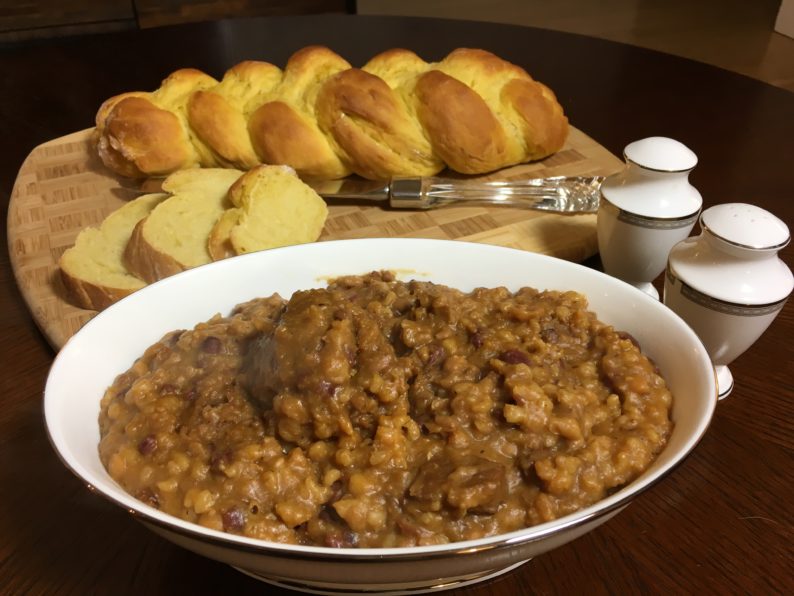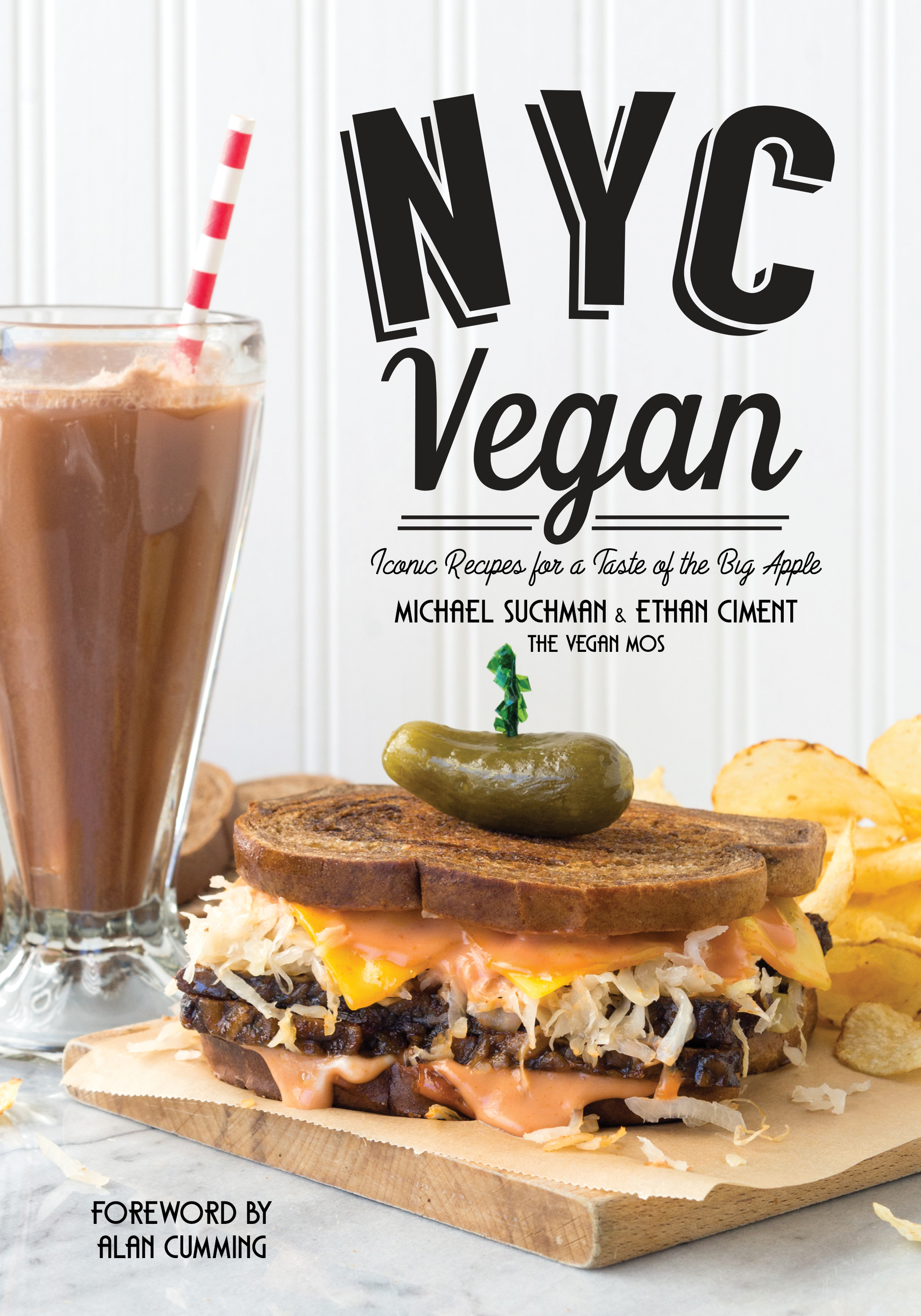My family ate Cholent with Helzel nearly every Saturday afternoon during my childhood. We would come home from morning services at synagogue knowing that this hearty, one-pot stew that had been cooking slowly overnight was finally ready to be eaten. Cholent evolved over hundreds of years of European Jewish life and is the result of a religious prohibition against cooking on the sabbath. The stew is brought to a boil on Friday afternoon before the sabbath commences at sundown, and then it’s kept warm overnight for on a hotplate or a blech until it is eaten for lunch the next day.
Historically, an Ashkenazi Cholent was made from a base of beef, potatoes, barley and beans, but there are many variations on this staple of Jewish cooking. Sephardic Jewish variations on Cholent use rice instead of beans and barely, chicken instead of beef, and whole eggs in the shell that turn brown overnight. Within Ashekenazi Jewish traditions, the many differences in Cholent reflect the regional influences of Eastern or Central Europe from whence they derived. My father’s family, coming from Hungary and the former Czechoslovakia, make a traditional Hungarian Cholent that originally derived from Sólet: a traditional Hungarian-Jewish stew made of kidney beans, barley, onion, paprika and beef. Sólet is still eaten today in Hungary, often with pork in place of the beef. One very typical Hungarian addition to Cholent is the inclusion of Helzel, a sausage of sorts (more info on that, below).
As a child, I always avoided eating the flanken (meat) in the Cholent, preferring the beans and helzel. As a vegan, I initially avoided making this recipe because I mistakenly thought that the beef was the primary flavoring agent in this slowly-simmering stew. You’ll be happy to know that, in fact, it is not. After I made a vegan version of my family’s famous cholent years ago, I can honestly say that the flavor profile is the same. Even my omnivorous father (who is eating more and more plant-based each day) now routinely makes a vegan cholent and enjoys it all the same. This recipe delivers all of the expected flavors but with a healthier, cholesterol-free and cruelty-free upgrade.
One thing to note about my use of a slow cooker: I do not use the slow cooker in the typical set-it-and-leave-it manner they are designed to be used. A Cholent requires continual tending, periodic stirring, scraping up the bottom of the pot, occasionally adding more water if too much is evaporating, and very carefully turning the Helzel to try to keep them from falling apart. So if you’re looking for a one pot set-it-and-leave-it kind of recipe, Cholent is not that recipe.
Prep Time: 45 minutes
Cooking Time: minimum 8 hours (or longer)
Ingredients:
1/4 cup vegetable oil
1 medium onion, finely diced
2 cloves of garlic, finely diced
8 ounce seitan, cut into 1″ cubes
15 ounce can of white beans (Northern, Navy or Cannelini) drained and rinsed, or 1½ cups if using fresh
15 ounce can of red beans (Kidney or small red) drained and rinsed, or 1½ cups if using fresh
1 cup pearled barley
4 cups beefless broth
1 cup boiling water
1 tablespoon onion powder
½ teaspoon garlic powder
¼ teaspoon ground black pepper
2 teaspoons Hungarian paprika
1 medium onion, whole, skin removed
2 Helzel balls (recipe follows, below)
Directions:
1. Heat the oil in an 8 quart pot on medium high. Add the diced onion and sauté until browned. Add the garlic and sauté for a minute longer.
2. Add the seitan and stir vigorously for 4-5 minutes, adding a tablespoon or two of the beefless broth as needed to keep the seitan, onions and garlic from sticking.
3. Add 1 cup of the broth and deglaze the bottom of the pan.
4. Add the beans, barley, remaining broth, onion powder, garlic powder, black pepper and paprika. Stir a few times to mix everything up well and then raise the heat to high, cover and bring to a boil. Once boiling, uncover the pot, stir well and continue boiling for 4 minutes stirring and scraping the bottom of the pot occasionally to prevent sticking.
5. Transfer the mixture to a slow cooker, add the whole onion and stir well. Gently place the two helzel balls into the slow cooker on opposite sides making sure they do not touch one another. Cover and cook on high for a minimum of 8 hours. Every 90 minutes or so, gently stir the mixture, turning the helzel and onions over so they cook evenly.
6. Serve in a bowl with vegan challah or your favorite bread for sopping, and enjoy.
Serves 4 to 6
HELZEL
Helzel is an Ashkenazi Jewish sausage that was historically made from ground internal organs, shmaltz (rendered chicken fat), flour and fried onions, sewn up in chicken skins. Thankfully, by the time I was born, my grandmother had already converted this recipe to a nearly vegan one, but for the use of eggs to bind it and wash it. With multiple egg replacement methods available today, her healthier version is now easily veganized and tastes exactly the same as the one she used to make. This “Jewish sausage” is best made the day before, as the longer it sits and chills in the refrigerator, the better. Overnight chilling isn’t necessary, but a two hour chill is mandatory.
Prep Time: 15 minutes (plus an overnight chill)
Yield: 2 balls
Ingredients
1/3 cup vegetable oil
1 medium onion, finely diced
1 cup cornflake crumbs
¼ teaspoon salt
2 tablespoons all purpose flour
4½ teaspoons Ener-G Egg Replacer
9 tablespoons water, divided
1 teaspoon ground flax seed
Directions:
1. Combine cornflake crumbs, salt and flour in a medium mixing bowl and set aside.
2. Heat oil in a 10 inch skillet on medium heat. Add onion and sauté for 7-8 minutes until evenly browned. Remove from heat and set aside and allow it to cool for a few minutes.
3. In a small bowl, combine Ener-G Egg Replacer and 6 tablespoons of water. Whisk until completely smooth.
4. In another small bowl, combine ground flax seeds with remaining 3 tablespoons of water and whisk well and set aside.
5. Add the cooled sautéd onions to the dry mixture, scraping the pan and including any residual oil in the pan. Mix well with a fork until a hard paste forms. Add half of the Ener-G Egg Replacer mixture and continue to mix well with a fork. Continue to add more of the Ener-G Egg Replacer mixture as needed until the batter begins to hold together. Be sure to reserve a few tablespoons of the Ener-G Egg Replacer mixture.
6. Divide the batter in half and tightly pack to form two equally sized balls. Add the flax mixture to the remaining Ener-G Egg replacer and mix to combine. Take each ball and gently roll it in the mixture to coat evenly over the surface of the entire ball. Place balls in a clean bowl, cover with plastic wrap and refrigerate for at least 2 hours before adding to Cholent.





